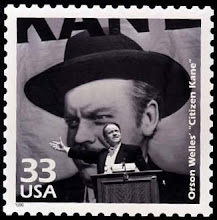
The Frank Sinatra stamps (Scott #4265) I used on these two musicals,
On the Town (Donen/Kelly, 1949) and
Anchors Aweigh (Sidney, 1945), only serve to remind us that Gene Kelly has yet to receive a stamp from the USPS. The fact that Fred Astaire also hasn’t been recognized made me think...are they preparing a Great Dancers issue? Still, the omission is quite conspicuous, especially since Judy Garland has gotten two already, completing the triumvirate of the most important actors in the history of the American musical.
I’ve always been a much bigger fan of Kelly, not because he was a better singer than Astaire (he wasn’t) or dancer (it’s a tie), but because he always seemed far more accessible. In his films, Astaire usually played a dancer. But Kelly played a soldier, sailor, ball player, actor, artist, ordinary working Joe. He wore khakis, not tuxedos. He was graceful, but also athletic. And while Astaire was usually kept apart from his love interest by circumstance, contrivance, or crossed wires, Kelly’s worst enemy was typically himself. He didn’t mind playing the heel, being unctuous and pushy. And sometimes, that shit-eating grin can annoy as much as charm.
An American in Paris (as beautiful as it is overrated) makes him a little too insufferable for my taste, stalking, rather than seducing, poor Leslie Caron.
But more often than not, that smile was a façade to darker recesses, for he was a far better actor than Astaire, tapping into his characters’ emotional depths and neuroses that played out in choreography that often was as tortured as it was jubilant. Astaire had a delightful, feather touch that played counter to what felt natural if forced to portray a bad guy (Exhibit A:
Yolanda and the Thief). But Kelly understood that such brazenness was a double-edged sword, that he could steamroll you with his energy, and that self-awareness makes his best performances (
The Pirate, Singin’ in the Rain, It’s Always Fair Weather) both charming and provocative.
A great comparison is between
Town and
Aweigh, for while he’s mostly a goof and a jerk in the latter, he’s wonderful in the former, finding a perfect pairing with Vera-Ellen while still being exceedingly generous with his hugely talented co-stars: Sinatra, Betty Garrett, Ann Miller, and Jules Munshin.
Town was the first film he co-directed with Stanley Donen (himself, vastly underappreciated for his contributions to so many 50’s musicals), but except for the ballet sequence, Kelly plays to the strengths of the ensemble instead of hogging the show.
Town is also the far better musical, despite abandoning huge chunks of the original stage show, with one boisterous number after number.
Aweigh is now mostly remembered for the inventive dance Kelly has with the animated Jerry the Mouse.
I was lucky to find two related stamps that fit perfectly with both the theme and the color scheme of the respective one sheets. The New York Skyline is an Air Mail stamp from 1947 (Scott #C35) and the Navy stamp (Scott #435) is from a year earlier. Note how Jose Iturbi gets prominent billing in the latter, because the one-sheet itself is Spanish.


























